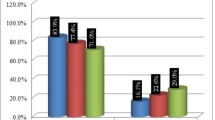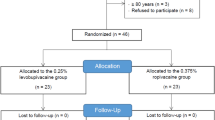Abstract
Background/aims Levobupivacaine, the S(–)-enantiomer of racemic bupivacaine, is associated with a similar efficacy but a reduced potential for cardiovascular and central nervous system toxicity than racemic bupivacaine. Thus, this prospective, randomised, double-masked study was undertaken to assess the efficacy and safety of 0.75% levobupivacaine vs0.75% bupivacaine, each with hyaluronidase, for peribulbar anaesthesia.
Methods A total of 60 patients undergoing elective anterior segment surgery were randomly allocated to receive either agent by a single, inferotemporal peribulbar injection technique, supplemented with a medial canthus injection if necessary. Ocular akinesia and orbicularis oculifunction were assessed by scoring systems at 2 min intervals until satisfactory akinesia was achieved, and movements were reassessed on the day after surgery to confirm regression of the block.
Results The time taken to reach a state of satisfactory anaesthesia and akinesia was deemed to be the primary measure of efficacy. Both agents achieved this in a similar median time of 2 min after receiving 5 ml of the injectate, and the treatment difference was not statistically significant (P=0.24). Blood samples from the first 20 patients were taken at intervals up to 4 h. These were analysed for plasma levels and confirmed similar plasma concentration vstime profiles for the two agents. Seven patients in each group (23%) complained of pain on injection but the technique was generally well tolerated. Two patients in the levobupivacaine group experienced serious adverse events, but neither was considered related to the study medication. The most common minor post-operative adverse event was prolongation of the local anaesthetic block, which was reported by nine patients (four in the levobupivacaine group and five in the bupivacaine group).
Conclusions Levobupivacaine and bupivacaine are equally successful in achieving clinically satisfactory peribulbar anaesthesia with few adverse effects.
Similar content being viewed by others
Log in or create a free account to read this content
Gain free access to this article, as well as selected content from this journal and more on nature.com
or
References
Köller C . Ueber die Verwendung des Cocains zur Anasthesitung an Auge. Wien Med Blätter 1884; 7: 1352–1355.
Knapp H . On cocaine and its use in ophthalmic and general surgery. Arch Ophthalmol 1884; 13: 402–448.
Grizzard WS, Kirk NM, Pavan PR et al. Perforating ocular injuries caused by anesthesia personnel. Ophthalmology 1991; 98: 1011–1016.
Fry RA, Henderson J . Local anaesthesia for eye surgery: the periocular technique. Anaesthesia 1989; 45: 14–17.
Davis DB . Posterior peribulbar anesthesia. J Cataract Refract Surg 1986; 12: 128–134.
Hamilton RC, Gimbel HV, Strunin L . Regional anaesthesia for 12,000 cataract extraction and intraocular lens implantation procedures. Can J Anaesth 1988; 35: 615–623.
Davis DB, Mandel MR . Efficacy and complication rate of 16,224 consecutive peribulbar blocks: a prospective multi-center study. J Cataract Refract Surg 1994; 20: 327–337.
Shriver PA, Sinha S, Galusha JH . Prospective study of the effectiveness of retrobulbar and peribulbar anaesthesia for anterior segment surgery. J Cataract Refract Surg 1992; 18: 162–165.
Albright GA . Cardiac arrest following regional anesthesia with etidocaine or bupivacaine. Anesthesiology 1979; 51: 285–287.
Rosenburg PH, Kalso EA, Tuominen MK et al. Acute bupivacaine toxicity as a result of venous leakage under the tourniquet cuff during a Bier's block. Anesthesiology 1983; 58: 95–98.
Mazoit JX, Boico O, Samii K . Myocardiac uptake of bupivacaine: pharmacokinetics and pharmacodynamics of bupivacaine enantiomers in the isolated perfused rabbit heart. Anesth Analg 1993; 77: 477–482.
Huang YF, Pryor ME, Mather LE et al. Cardiovascular and central nervous system effects of intravenous levobupivacaine and bupivacaine in sheep. Anesth Analg 1998; 86: 797–804.
Cox CR, Checketts MR, Mackenzie N et al. Comparison of S(–)-bupivacaine with racemic (RS)-bupivacaine in supraclavicular brachial plexus block. Br J Anaesth 1998; 80: 594–598.
Miller DK, Haman SM . Graphical aid for determining the power of clinical trials involving two groups. Br J Med 1988; 297: 672–676.
House PH, Hollands RH, Schulzer M . Choice of anesthetic agents for peribulbar anesthesia. J Cataract Refract Surg 1991; 17: 80–83.
Morsmann CD, Holden R . The effects of adrenaline, hyaluronidase and age on peribulbar anaesthesia. Eye 1992; 6: 290–292.
Döpfmer UR, Maloney DG, Gaynor PA et al. Prilocaine 3% is superior to a mixture of bupivacaine and lignocaine for peribulbar anaesthesia. Br J Anaesth 1996; 76: 77–80.
Aberg G . Toxicological and local anaesthetic effects of optically active isomers of two local anaesthetic compounds. Acta Pharmacol Toxicol 1972; 31: 273–286.
Clarkson CW, Hondeghem LM . Mechanism for bupivacaine depression of cardiac conduction: fast block of sodium channels during the action potential with slow recovery from the block during diastole. Anesthesiology 1985; 62: 396–405.
Vanhoutte F, Vereecke J, Verbeke N et al. Stereoselective effects of the enantiomers of bupivacaine on the electrophysiological properties of the guinea-pig papillary muscle. Br J Pharmacol 1991; 103: 1275–1281.
Valenzuela C, Delpon E, Tamkun MM et al. Stereoselective block of human cardiac potassium channels (Kvl.5) by bupivacaine enantiomers. Biophys J 1995; 65: 418–427.
Denson DD, Behbehani MM, Gregg RV . Enantiomer-specific effects of an intravenously administered arrythmogenic dose of bupivacaine on neurons of the nucleus tractus solitarius and the cardiovascular system in the anesthetised rat. Reg Anesth 1992; 17: 311–316.
Aps C, Reynolds F . An intradermal study of the local anaesthetic and vascular effects of the isomers of bupivacaine. Br J Clin Pharmacol 1978; 6: 63–68.
Fernandes L, Simonetti MPB . Vascular effects of S(–)-bupivacaine, RS bupivacaine and ropivacaine on isolated strips of human umbilical vein: preliminary results. Reg Anaesth 1997; 22(Suppl 2): 65.
Acknowledgements
This study was sponsored by Chiroscience Limited. We are very grateful to all the staff at the Royal Eye Infirmary, Plymouth, particularly Mr NM Evans, Mr VT Thaller, Mr John Rigby and Mrs Jayne Wootten-Pineles. We also thank Mrs Sue Levie and Mrs Karen Forbes at Inveresk Clinical Research for their assistance in designing the study.
Author information
Authors and Affiliations
Corresponding author
Rights and permissions
About this article
Cite this article
Birt, D., Cummings, G. The efficacy and safety of 0.75% levobupivacaine vs 0.75% bupivacaine for peribulbar anaesthesia. Eye 17, 200–206 (2003). https://doi.org/10.1038/sj.eye.6700313
Published:
Issue date:
DOI: https://doi.org/10.1038/sj.eye.6700313
Keywords
This article is cited by
-
Levobupivacain in der Regionalanästhesie
Der Anaesthesist (2006)



